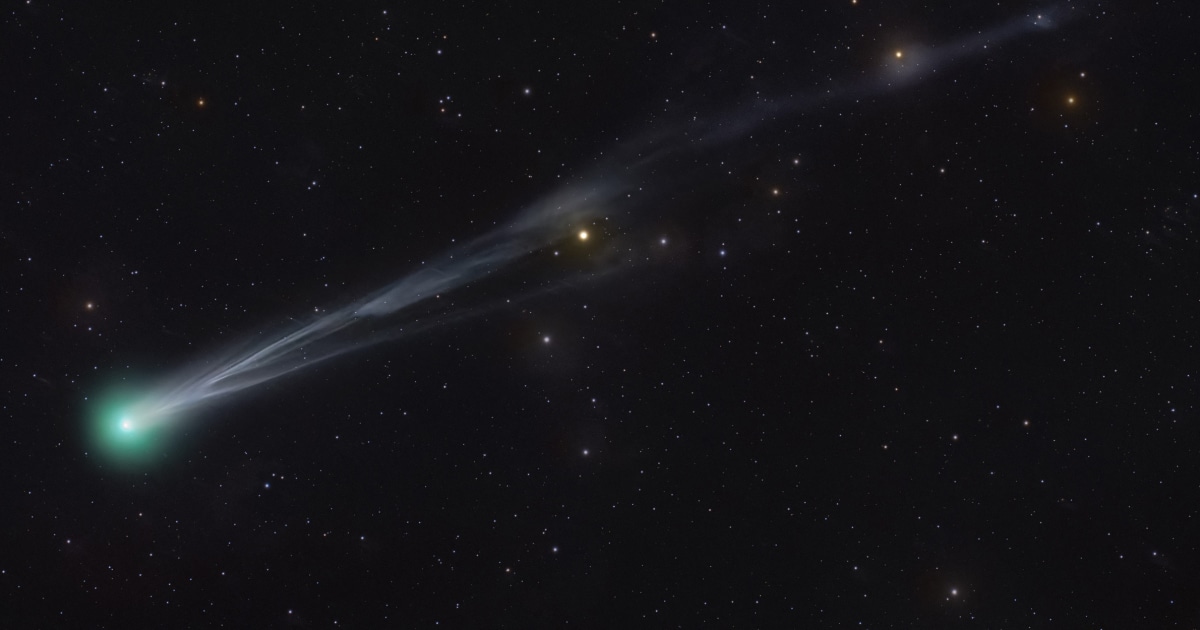APPLETON, Wis. — Skywatchers across the Northern Hemisphere have a rare treat this October as two greenish comets streak through the night sky, offering a chance to glimpse these icy visitors from the outer solar system. The comets, known as C/2025 A6 (Lemmon) and C/2025 R2 (SWAN), are making their way closer to Earth and the sun, with experts predicting peak visibility in the coming weeks.
According to a report from NBC News, these celestial objects are swinging through the inner solar system this fall, providing an uncommon opportunity to spot two comets in the same month. Comet Lemmon, discovered in January by the Mount Lemmon Survey in Arizona, is already drawing attention for its emerald glow, while Comet SWAN, spotted just last month, adds to the excitement with its evening appearances.
Astrophotographer Julien De Winter, a junior lecturer at the University of Mons in Belgium, captured stunning images of Comet Lemmon in late September from Texas. His photographs show the comet's dramatic emerald glow and long tail, highlighting the faint green color that comes from carbon in the gas cloud surrounding the nucleus.
The Mount Lemmon Survey, which tracks near-Earth objects using telescopes in the Santa Catalina Mountains, first identified Comet Lemmon earlier this year. Officials from the survey noted that the comet's orbit brings it to its closest point to Earth around Oct. 21, when it could become visible to the naked eye under ideal conditions.
In the Northern Hemisphere, Comet Lemmon is currently visible near the Big Dipper before dawn, according to EarthSky, a website dedicated to astronomy. Viewers should look northeast in the pre-dawn hours, slightly below the stars forming the bowl and handle of the Big Dipper. By mid-October, the comet will shift to the evening sky, rising in the west and potentially bright enough for unaided viewing through the end of the month.
Comet SWAN, discovered in early September by an amateur astronomer reviewing images from NASA's Solar & Heliospheric Observatory (SOHO), is best seen in the evening. The SOHO mission, launched in 1995 to study the sun, provided the data that led to this find. Observers are advised to look southwest about 90 minutes after sunset, using binoculars or a small telescope, as it likely won't be bright enough for the naked eye.
As Comet SWAN approaches its closest point to Earth around Oct. 20, it may grow brighter and appear higher on the horizon after sunset. Under clear, dark skies with minimal light pollution, sky enthusiasts might even spot both comets on the same night toward the end of October, according to astronomy reports.
These comets are composed of ice, dust, and rocky material, and as they near the sun, the heat causes them to release gases, creating their characteristic tails and glows. The greenish hue, as explained in the NBC News report, stems from diatomic carbon molecules in the coma, the cloud enveloping the nucleus.
While two comets in one month is rare, this October also features a third visitor: Comet 3I/ATLAS, an interstellar comet from outside our solar system. This marks only the third confirmed interstellar comet, and it was recently photographed by a spacecraft orbiting Mars. It will make its closest approach to the sun around Oct. 30.
Denise Chow, a science and space reporter for NBC News, described the event as a 'rare chance' for skywatchers. She noted that both Comet Lemmon and Comet SWAN are 'greenish-hued' and visible with basic equipment through the end of the month.
'The faint green color comes from the presence of carbon in the cloud of gas that surrounds the comet’s nucleus,' Chow reported, attributing the explanation to astronomical observations.
Historical context adds to the allure; comets have fascinated humans for centuries, often seen as omens or harbingers. The last major comet visible to the naked eye was Comet NEOWISE in 2020, which drew global attention. Unlike periodic comets like Halley's, which return every 76 years, these are long-period or potentially one-time visitors, making their appearances unpredictable.
Astronomers emphasize the importance of dark skies for optimal viewing. Light pollution from cities can obscure fainter objects, so rural locations or designated dark-sky parks are recommended. Apps and websites like EarthSky provide star charts and real-time updates to help locate the comets.
Looking ahead, as these comets continue their journeys, they may offer insights into the solar system's formation. Samples from past comet missions, such as NASA's Stardust, have revealed organic compounds, hinting at comets' role in delivering water and building blocks of life to Earth billions of years ago.
The simultaneous appearance of these comets underscores the dynamic nature of our cosmic neighborhood. With Comet 3I/ATLAS adding an interstellar dimension, October 2025 is shaping up as a banner month for astronomy enthusiasts. As the comets fade from view by November, researchers will continue monitoring their paths, potentially uncovering more about their origins and compositions.
